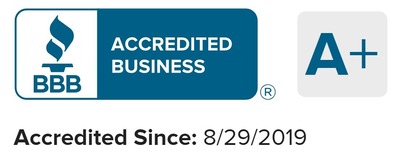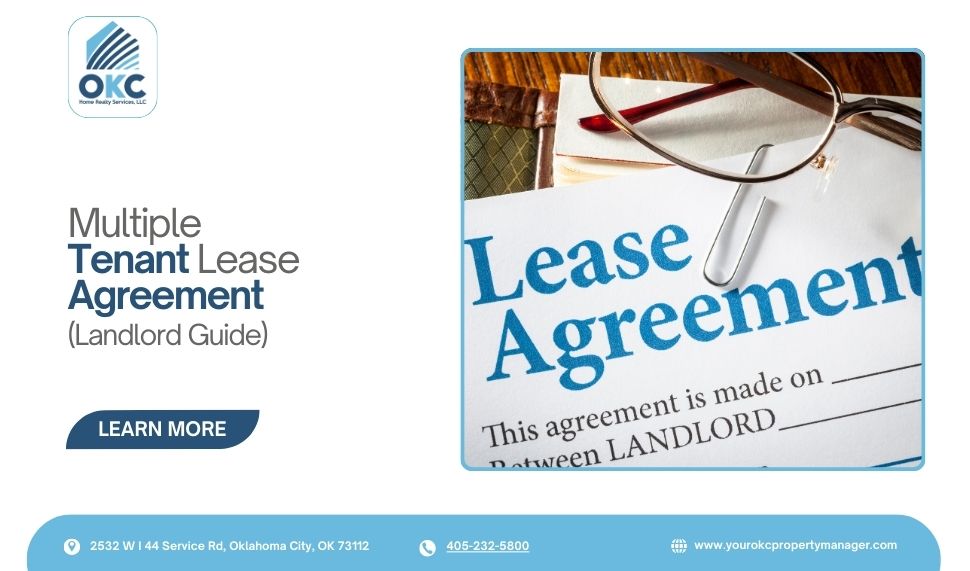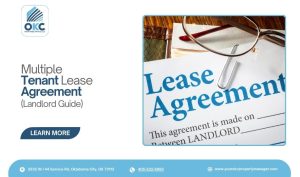Renting to more than one tenant under the same roof has become extremely common, especially in growing rental markets like Oklahoma City, Edmond, Norman, Yukon, Moore, and Midwest City. With rising housing demand, higher rental prices, and more renters choosing to split costs, shared living arrangements are now the norm rather than the exception.
For landlords and property investors, these shifts create both new opportunities and challenges. More tenants can mean higher occupancy rates and reliable rental income, but only if you use the right lease structure. That’s where a Multiple Tenant Lease Agreement comes in. Also known as a joint lease, roommate lease, or co-tenant agreement, this type of lease protects your property, clarifies responsibilities, and helps prevent the disputes that often arise when people share living spaces.
Whether you’re new to property management or already managing multiple rentals, you’ll eventually deal with situations where two or more tenants sign the same lease, roommates, unmarried couples, business partners, adult children living with parents, or even friends sharing a home. A standard one-tenant lease simply doesn’t cover the complexities that come with:
- Rent splitting
- Shared responsibilities
- Damages caused by any tenant or guest
- Turnover and replacements
- Co-tenant disputes
- Eviction complications
A Multiple Tenant Lease Agreement is specifically designed to handle these situations and reduce your legal and financial risks. When written correctly, it helps you maintain smooth operations, protect your property, and ensure clear communication between all tenants.
With over two decades of managing rental properties in Oklahoma, I’ll walk you through everything you need to know.
Let’s dive in.
What is a Multiple Tenant Lease Agreement?
A multiple tenant lease agreement is a rental contract where two or more tenants sign the same lease and share full responsibility for:
- Paying the entire rent
- Following all lease rules
- Maintaining the property
- Covering damages
- Complying with local landlord-tenant laws
This agreement is different from renting separate rooms individually. Instead, the entire group shares the property, and the responsibilities.
This type of agreement is common in:
- Single-family rentals
- College housing
- Multi-bedroom apartments
- Shared homes
- Duplexes
- Townhomes
Landlords use this type of lease to create legal clarity and prevent disputes. Without one, you could end up chasing multiple tenants for unpaid rent, dealing with unexpected “extra” roommates, or facing confusion when someone moves out early.
When do Landlords Use Multiple Tenant Leases?
Landlords use multiple tenant lease agreements anytime two or more adults share the same rental and should be legally responsible for the terms of the lease. This setup is far more common than most owners realize, especially in markets like Oklahoma City, Edmond, Norman, Yukon, Moore, and Midwest City, where shared rentals are steadily increasing.
Here are the most common situations where a multiple tenant lease is the best option:
1. Roommates of Friends Sharing a Rental
This is the number one reason landlords use a joint lease. Two or more adults choose to split the rent and utilities to reduce living costs. Without a shared lease, disputes and “he said, she said” situations are far more likely.
2. Unmarried or Co-Living Couples
Even if they’re not legally married, couples living together should both sign the lease. This protects the landlord if one partner moves out or stops paying.
3. Students in College Towns
Cities like Norman, Stillwater, and Edmond have strong student housing markets. Multi-tenant leases are essential in situation where:
- Roommates share off-campus apartments
- Students rotate frequently
- Turnover is high
- Rent is split equally (or unequally)
A well-written joint lease reduces risk when tenants come and go throughout the school year.
4. Families With Adult Children
In many households, adult children or even extended family members, live together and contribute financially. When everyone signs the lease, it:
- Sets clear expectations
- Helps with rent enforcement
- Reduces disputes over responsibility
5. Workforce Housing and Co-Workers Sharing a Home
Some industries see employees renting together to reduce costs or because employers recommend shared housing. A joint lease keeps every co-worker accountable.
6. Co-Living or Shared Housing Arrangements
Co-living is a growing trend in many U.S. markets and is slowly expanding across Oklahoma. These setups involve multiple unrelated adults who share kitchens, bathrooms, or common areas. A multiple tenant lease clearly outlines:
- Shared responsibilities
- Rent contributions
- Damage liability
7. Business Partners Renting Together
Occasionally, business partners rent a residential or mixed-use property together. A joint lease ensures each partner has equal responsibility for rent maintenance, and lease compliance.
Why Joint Lease Matters for Property Owners
A well-structured co-tenant lease agreement is one of the strongest tools a landlord can use to protect their property, income, and legal rights. When you have several adults living under one roof, things can get complicated fast unless everyone signs the same agreement and shares the same responsibilities.
Here’s why this type of lease matters so much for property owners and investors:
1. Clear Responsibility and Accountability
With one joint lease, all tenants agree to the same rules. This eliminates confusion or excuses like:
- “I didn’t know about that rule.”
- “My roommate was supposed to pay that.”
- “I’m only responsible for my part.”
Everything is written clearly, so you avoid the classic “he said, she said” problems.
2. Strong Financial Protection (Shared Risk)
Instead of relying on just one person’s income, the financial responsibility is spread across all tenants. If one tenant:
- Loses a job
- Moves out unexpectedly
- Refuses to pay
The others are still legally required to cover the full rent. This dramatically reduces the landlord’s risk of nonpayments.
3. Lower Vacancy and Turnover Risk
When one tenant leaves, the remaining occupants still:
- Owe the full rent
- Must follow all lease terms
- Are responsible for finding a landlord-approved replacement (if your lease permits)
This helps prevent sudden vacancies or long periods without rent.
4. Simpler Property Management
Even if there are three or four tenants in the home, the lease remains simple:
- One lease
- One due date
- One security deposit
- One renewal date
- One set of rules and expectations
This keeps communication, recordkeeping, and enforcement much easier for landlords.
5. Strong Legal Protection
A multiple tenant lease protects property owners when issues arise, such as:
- Unpaid rent
- Resident-caused damages
- Violations of the lease
- Noise or nuisance complaints
- Unauthorized occupants
- The need pursue eviction
Because all tenants are legally tied to the same document, landlords have a much stronger foundation for enforcing rules and taking action when needed.
The Role of Joint and Several Liability (Why It’s the Most Important Clause)
If you only remember one thing about multiple tenant leases, remember this:
Joint and several liability is the clause that protects landlords the most.
It’s the backbone of every solid multiple tenant lease agreement and the #1 way to reduce financial risk when renting to roommates, partners, students, or shared households.
What Joint and Several Liability Means
Under this clause, every tenant is responsible for the entire lease, not just their individual share.
That means each tenant is fully responsible for:
- The full rent
- All damages
- All lease violations
- Any overdue balances
- Any costs associated with eviction
Even if only one tenant caused the issue, all tenants share the responsibility.
For example:
Your rent is $2,100 per month.
If one roommate refuses to pay their portion, the remaining tenants must:
- Pay the full amount $2,100
- Cover the missing amount immediately
- Deal with the roommate situation on their own
You don’t have to mediate, negotiate, or chase three different people for three different amounts.
Why this clause is Critical for landlords
Without joint and several liability:
- You may have to chase each roommate individually
- Rent becomes inconsistent because everyone feels responsible for only their part
- Roommates argue about money and stop paying
- You lose leverage during disputes
- Eviction become more complicated
With joint and several liability:
- You get paid in full, on time
- Tenants hold each other accountable
- Roommates solve their own conflicts
- Landlords avoid involving themselves in roommate disagreements
- Legal enforcement becomes much easier
Industry surveys show that over 60% of multi-tenant disputes involve money, not behaviour.
Joint and several liability significantly reduces financial risk because it ensures:
- One late payer doesn’t sink the whole group.
- You can collect rent from any responsible tenant.
- The group self-regulates when someone isn’t contributing.
This one clause alone can save landlords thousands of dollars in lost rent, legal fees, and avoidable disputes.
Key Elements Every Multiple Tenant Lease Should Include
A strong roommate lease isn’t just helpful; it’s essential. It protects your property, reduces conflict among tenants, and gives you a legal foundation if a problem ever arises. Below is a complete checklist of the must-have components every landlord should include.
1. Names of All Tenants (No Exceptions)
Every adult living in the rental must:
- Apply
- Be screened
- Be approved
- Sign the lease
This gives you full legal protection.
If someone lives in the unit but isn’t on the lease, you cannot fully enforce your rules or pursue them for damages.
2. Rent Amount and Payment Terms
Your lease should clearly state:
- Total monthly rent
- Due date
- Acceptable forms of payment
- Late fees and grace periods
- Shared responsibility for the full amount
Avoid listing rent “per person.” Instead, use language like:
“Tenants may divide rent among themselves, but the full rent amount is due regardless of internal arrangements.”
This keeps you protected if one tenant stops paying.
3. Security Deposit Rules
A single security deposit keeps things clean and simple.
Include:
- Total amount collected
- How deductions will be made
- Joint responsibility for damages
- Move-out inspection process
- Deposit return timeline
Important: You return the deposit to the group as a whole, not individual tenants.
This prevents you from being dragged into their arguments over who gets what.
4. Utility and Service Responsibilities
Prevent disputes by clearly defining who pays for:
- Electricity
- Water
- Gas
- Trash
- Internet
- Lawn care
- Pest control
For shared bills, state:
“Tenants are jointly responsible for all utility charges.”
This stops tenants from trying to blame each other and you when bills aren’t paid.
5. Rules for Replacing or Adding Tenants
This is one of the most important sections because roommate turnover is common.
A strong policy should include:
- Written notice is required for any changes
- Landlord screening and approval of new tenants
- Signed lease amendment for all tenants
- Outgoing tenant remains liable until officially removed
- Fees or administrative charges (if applicable)
This one clause alone prevents up to 80% of tenant confusion during roommate changes.
6. House Rules and Property Policies
Set clear expectations for behavior and shared spaces.
Include rules for:
- Quiet hours
- Smoking or vaping
- Parking assignments
- Pet policies
- Parties and large gatherings
- Cleanliness in common areas
- Guest limits (overnight guest rules are crucial in shared rentals)
These rules prevent tension and help maintain your property.
7. Maintenance Responsibilities
Tenants should handle basic, low-cost tasks like:
- Changing HVAC filters
- Replacing light bulbs
- Routine cleaning
- Yard work (if required)
- Reporting maintenance issues promptly
List these expectations clearly so tenants can’t claim “I didn’t know.”
8. Move-Out Procedures
Eliminate last-minute disagreements by outlining:
- Cleaning standards
- Inspection steps
- How damages are calculated
- Fees for excessive cleaning
- Deposit return timeline (state law may specify)
Make it clear that the group is responsible for ensuring the unit is move-out ready.
9. Dispute Resolution Rules
You should never act as a mediator between roommates.
Include a clause such as:
“The landlord is not responsible for resolving disputes between co-tenants. All disagreements must be settled internally by tenants.”
This keeps you neutral and out of roommate conflicts.
10. Renter’s Insurance Requirement
Require each tenant to carry their own policy.
Most policies cost only $15–$20 per month and protect both the tenant and the landlord by covering:
- Tenant belongings
- Accidental damage
- Liability if they cause harm or fire
This is a low-cost way to reduce major risk.
Pros and Cons of Multi-Tenant Lease Agreements for Landlords
Joint lease agreements can be a smart strategy for landlords, especially in areas with strong student populations, young professionals, or industries that hire seasonal or short-term workers. But like any rental approach, it comes with its own advantages and challenges.
Here’s a clear breakdown to help you decide whether this setup fits your property.
Pros of Multi-Tenant Leases
1. Higher Rental Income
When multiple renters share a property, the combined rent they’re willing to pay is often higher than what a single household can afford. This makes multi-tenant rentals a strategic way to boost cash flow.
2. Lower Financial Risk (Shared Liability)
Most multi-tenant leases use joint and several liability, meaning each tenant is responsible for the full rent. If one roommate can’t pay, the others are still legally obligated to cover it. This reduces the likelihood of missed payments.
3. Strong Demand From Key Renter Groups
Roommate-style rentals are especially popular among:
- College students
- Young professionals
- New hires relocating for work
- Seasonal workers and interns
These groups often prefer shared housing because it keeps costs low.
4. Reduced Vacancy and Longer Tenancies
Roommate groups tend to stay longer because:
- Rent is affordable when split
- They already know each other
- Many choose to renew together year after year
Even better, if one person moves out, the group often replaces them without breaking the lease.
5. Less Turnover Headache
Even when one roommate leaves, the remaining tenants stay in place. This saves you time and money on:
- Marketing
- Cleaning
- Touch-ups
- Re-leasing the property
You’re not starting from zero every time someone moves out.
6. Strong Legal Protection
A multi-tenant lease with joint liability gives landlords more enforcement power. Everyone is equally responsible for rent, damages, and lease compliance.
Cons of Multi-Tenant Leases
1. Higher Wear and Tear
More people living in the home means:
- More foot traffic
- More appliance usage
- More bathroom and plumbing stress
- Faster deterioration of flooring and paint
Expect increased long-term maintenance.
2. More Maintenance Requests
Four renters don’t just occupy a home; they notice four different sets of potential problems. That means more:
- Emails
- Calls
- Repair tickets
Even minor things get reported more often.
3. Roommate Conflict
Interpersonal issues aren’t your responsibility, but they can affect:
- Payment consistency
- Noise complaints
- Requests to break the lease
- Overall property condition
Good communication and clear rules help minimize problems.
4. Parking and Space Challenges
More tenants usually mean more vehicles. This can lead to:
- Street parking overflow
- Neighbor complaints
- Tension between roommates over limited driveway space
Properties with small driveways or strict HOA rules may face added pressure.
5. Risk of Unauthorized Occupants
With multi-tenant setups, it’s common for:
- Friends
- Boyfriends/girlfriends
- Additional roommates
to quietly move in without going through screening. Regular inspections and clear lease language help manage this risk.
Legal Considerations for Multiple Tenant Leases
Before renting to multiple tenants under one lease, landlords must understand the legal requirements that protect both you and your renters. Following the right rules helps you avoid fines, discrimination claims, and lease disputes.
1. Fair Housing Compliance
Fair Housing Laws apply to all rental situations, including multi-tenant or roommate leases. This means you cannot choose tenants based on protected characteristics such as:
- Race
- Religion
- Age (in most cases)
- National origin
- Disability
- Family status
- Sexual orientation
- Gender identity
Your screening criteria must be consistent and applied to every applicant. For example:
- If you check credit score, check them for everyone.
- If you verify income, verify it for everyone.
- If you run background checks, run them for everyone.
Equal treatment is key.
2. Occupancy Limits
Most jurisdictions use the “two people per bedroom” guideline, but this can vary based on:
- State housing codes
- City ordinances
- Fire or health department rules
- Square footage requirements
Some cities allow more people, some allow fewer, and some have stricter rules for older homes.
Before approving a group of tenants, always check the local occupancy regulations where your property is located.
3. Notice Requirements
Landlords must follow state and local notice laws, which may include:.
Entry & Inspections
Most states require landlords to give 24-48 hours notice before entering the property unless it’s an emergency.
Rent Increases
Depending on the state, you may need:
- 30 days notice
- 60 days notice (common for larger increases)
Eviction Procedures
Eviction timelines can differ widely and may include:
- Required written notices
- Court filling rules
- Specific timelines before lockout or removal
Always follow the exact process for your state, guessing can lead to delays or dismissed cases.
4. Lease Enforceability
For a multi-tenant lease to be legally enforceable, it needs to be:
- Clear – outlining responsibilities, rent amounts, and rules
- Written – verbal agreements are risky and often unenforceable
- Signed by all tenants – every adult must be legally responsible
If you’re using a joint and several liability clauses, make sure it’s clearly explained and included in writing.
Best Practices for Landlords Using Multi-Tenant Leases
Managing a property with multiple tenants under one lease runs smoothly when you set clear systems and expectations. Here are the key best practices every landlord should follow:
1. Use One Lease, Not Separate Leases
Always place all tenants on one single lease agreement.
Separate leases create:
- Confusion about who is responsible
- Legal gaps
- Disputes over individual portions
- Enforcement challenges
One lease = one set of rules, one payment, and full protection.
2. Communicate Expectations Clearly From the Start
Before tenants sign, explain:
- Joint and several liability
- Payment responsibility
- Behavior expectations
- House rules
When renters understand their obligations early, you avoid misunderstandings later.
3. Collect Rent Online
Online payments make everything easier:
- Tenants can split payments privately
- Your receive one full deposit
- No excuses about who paid or who didn’t
- Cleaner records for potential disputes
It cuts down on drama, especially with roommate groups.
4. Require Renter’s Insurance
Renter’s insurance is inexpensive (usually $15-$20 per month per tenant) and provides:
- Liability protection
- Personal property coverage
- Peace of mind for everyone
Make it a mandatory lease requirement.
5. Inspect the Property Regularly
Multi-tenant homes see more wear and tear. Protect your investment with inspections every 4-6 months.
Regular walk-throughs help you catch:
- Unauthorized occupants
- Lease violations
- Maintenance issues
- Pet problems
Early detection saves money.
6. Keep All Tenants on the Same Renewal Schedule
Do not stagger renewals. Renew the lease as a group, not individually. This prevents:
- Partial move-outs
- Rent payment confusion
- Lease gaps
Group renewals keep everyone accountable.
7. Document Everything
Good documentation protects landlords more than anything else. Keep organized records of:
- Photos and videos (move-in and move-out)
- Emails and text communications
- Lease drafts and signed versions
- Maintenance and inspection reports
Rental industry surveys show that proper documentation reduces dispute risk by over 70%.
Is a Multiple Tenant Lease Agreement Right for You?
A Multiple Tenant Lease Agreement is one of the best tools for reducing landlord risk and maintaining consistent cash flow. When designed well, it protects your property, simplifies management, and keeps everyone accountable.
With clear rules, strong screening, and joint liability, landlords can rent to groups confidently, whether in Oklahoma City, Edmond, Norman, or anywhere in the U.S.
Need reliable property management for your multi-tenant or roommate rentals? OKC Home Realty Services can handle screening, leases, rent collection, and ongoing management.
Get a free rental analysis today and see how much your property can earn.
FAQs: Multiple Tenant Lease Agreement
Can one tenant be removed from the lease?
Yes, but only with landlord approval and a signed amendment.
Can one tenant break the lease early?
They can move out, but they cannot break the lease for everyone.
Who gets the security deposit back?
The group as a whole.
What if tenants argue over rent?
It’s not the landlord’s responsibility. Rent must be paid in full regardless of disputes.
What if tenants get into a fight?
Landlords are not mediators. As long as rules are followed and rent is paid, the internal dispute is their to resolve.
Do tenants need individual renter’s insurance?
Yes, each tenant should carry their own policy.
What if one tenant causes damage?
All tenants are liable.
Can a landlord have two leases on the same property?
Yes, but only in specific situations and you must structure it correctly to avoid major legal and financial problems.
How does renting with multiple people work?
Renting with multiple people works best when there is one clear lease, joint responsibility, and well-defined rules. It benefits tenants financially and protects landlords legally.

Author
Scott Nachatilo is an investor, property manager and owner of OKC Home Realty Services – one of the best property management companies in Oklahoma City. His mission is to help landlords and real estate investors to manage their property in Oklahoma.
 (
(









